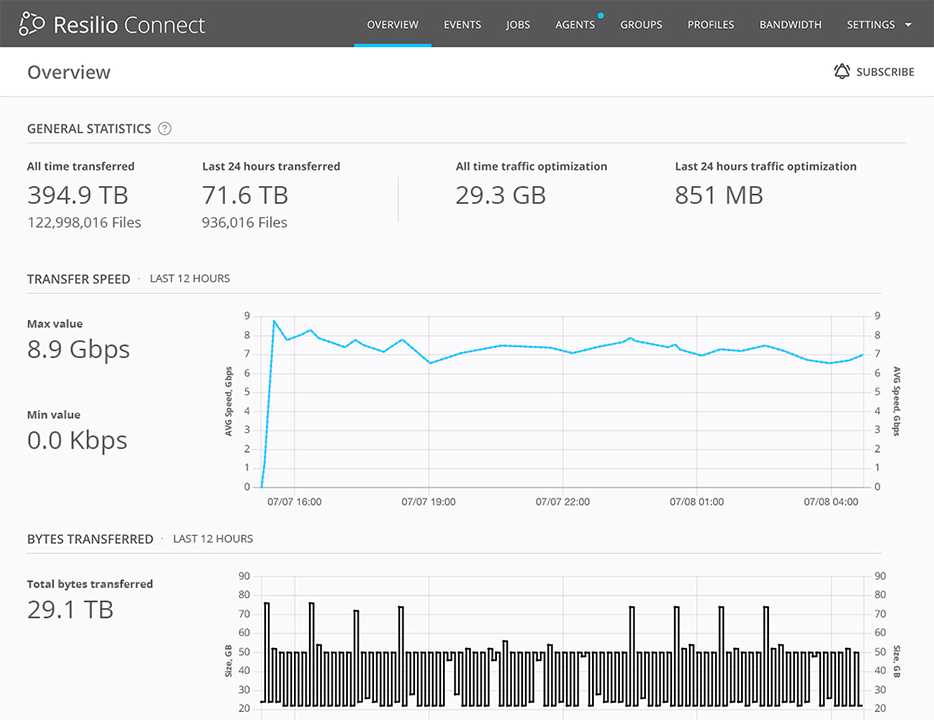While Amazon Web Services (AWS) has one of the most robust infrastructures among cloud providers, its data transfer latency can be unpredictable both within and across regions. Latency wreaks havoc with conventional TCP-based replication.
CloudPing has a very useful page that illustrates how much AWS latency can vary:
As you might expect, geographic distance plays a big role here. The latency between AWS regions that are close to each other, like eu-central-1 (Frankfurt), eu-west-1 (Ireland), and eu-south-1 (Milan) is much lower compared to geographically dispersed regions, like ap-south-1 (Mumbai), us-east-1 (N. Virginia), and us-west-2 (Oregon).
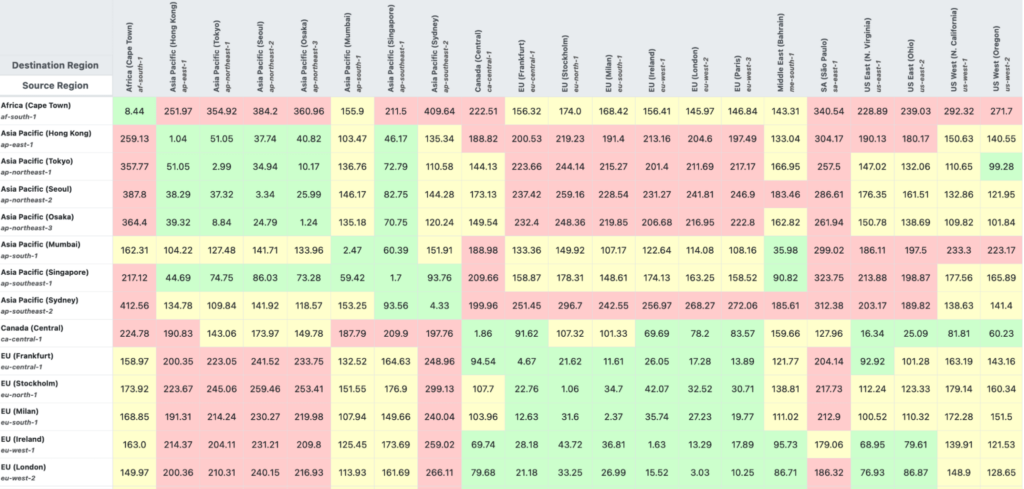
At the same time, tons of other variables can also affect latency, including when and how regions were built, the Availability Zones (i.e., data centers) in them, and more.
For example, Concurrency Labs ran a very interesting test by uploading a 1MB file and a 10 MB one from EC2 to S3. The test showed that the intra-region latency can vary wildly, from 81 milliseconds (ms) in the Ohio region to 165ms in Sydney, 247 ms in Singapore, 681ms in Sao Paulo, and 775ms in Tokyo. The inter-region latency was even more volatile.
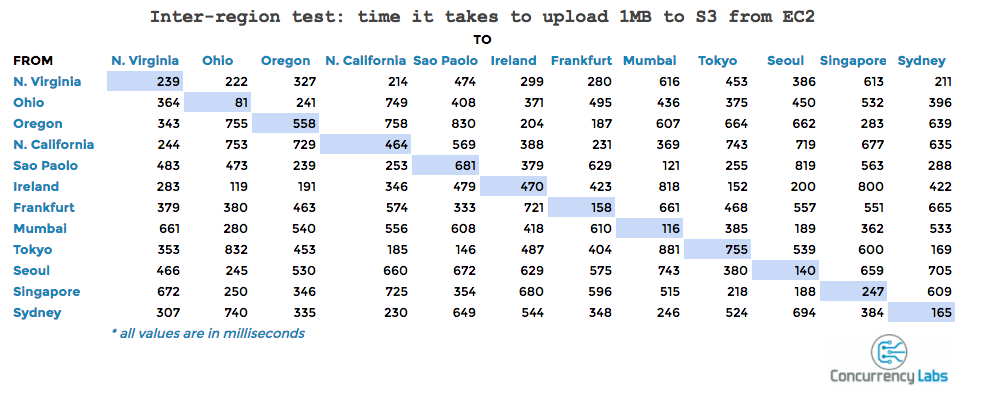
AWS has some services that can help deal with latency and data transfer speeds, like:
- S3 Transfer Acceleration for long-distance object transfers.
- S3 Replication Time Control (S3 RTC) for replicating objects.
- AWS Global Accelerator for accelerating API workloads and using deterministically routing traffic to a fleet of EC2 instances.
However, there’s no single AWS service that can ensure low latency and fast data transfer speeds in every scenario. This makes the process of estimating and reducing latency very difficult as organizations have to learn how various AWS services work and constantly experiment with different setups.
In this guide, we’ll show you how Resilio Connect — our WAN optimized replication solution — overcomes these challenges to get fast, reliable, and predictable data transfers every time. The solution is also cloud-independent, so you can replicate files across any location using any IT or cloud infrastructure, in any combination.
Specifically, we’ll provide more details on how Resilio Connect can help you:
- Move data into and out of AWS quickly and efficiently.
- Overcome latency and packet loss across all cloud regions, regardless of distance.
- Get granular control and visibility over the data transfer process from a single place (as opposed to relying on 3-5 AWS services for different use cases).
- Avoid vendor lock-in by transferring data across other cloud providers’ networks and using any mix of hybrid and on-prem storage.
- Use S3 object storage from a number of vendors, as well as DAS, NAS, and SAN.
We’ll start by discussing the limitations of traditional data transfer topologies and how Resilio Connect overcomes them.
For more details on how Resilio Connect can help your organization, schedule a demo with our team.
The Central Limitations of Traditional Data Transfer Topologies (& How Resilio Overcomes Them)
There are two fundamental challenges with traditional data transfer and replication:
- They’re TCP-based.
- They’re Point-to-Point (aka client-server).
Most conventional replication tools — including those offered by AWS — use TCP as the underlying transport even when dealing with Wide Area Networks (WANs).
TCP is okay for Local Area Networks (LANs) but not suitable for WANs. TCP suffers due to a number of factors operating over distance and even small levels of latency and packet loss degrade its performance.
Mainly, TCP treats packet loss as a network congestion issue and slows down the transfer speeds as a response. But packet loss is a defining characteristic of WANs and not a network congestion problem. This slows down transfer speeds unnecessarily and prevents organizations from:
- Making the most out of expensive WAN connections.
- Transferring and syncing data across the globe quickly and reliably.
The second issue is architecture: Most data transfer and replication solutions (including those offered by AWS) use one of two typical replication topologies — client-server or “follow-the-sun”.
In the client-server context, one device acts as a hub that can receive and share data with any of the other devices. However, the clients can’t share data with each other. For example, if Client 1 wants to transfer data to Client 2, it must first share that data with the hub, which in turn transfers it to Client 2.
This topology has a few issues:
- It has a single point of failure (the hub server).
- It’s reliant on “cloud hopping” — the process of going from Client 1 to the hub, instead of just going from Client 1 to Client 2 — which inevitably slows down data transfers.
- The hub server can transfer data to only one device at a time. In other words, it must finish transferring data to a specific device before it can begin transferring to others. If one device is experiencing any sort of issue (slow network, outage, etc.), the transfer to all other devices can be obstructed.
- Scaling up the environment is costly. The more client devices you add, the more hub servers you need to buy. Plus, you need to find a way to balance the network load between the hubs.
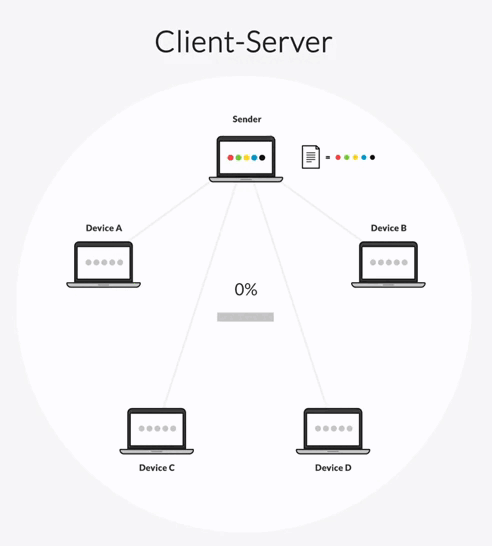
In the “follow-the-sun” context, data transfers occur sequentially, from one device to the next. For example, Device 1 must transfer files to Device 2, which then transfers them to Device 3, and so on.
While slightly different, this topology faces the same issues as transfers are limited to one device at a time, so there’s a single point of failure and unnecessary slowdowns of the transfer process.
Solution #1: Proprietary WAN Optimization Technology
Instead of relying on TCP/IP, Resilio uses a proprietary UDP-based transfer protocol called Zero Gravity Transport (ZGT™).
ZGT is specifically built for maximizing transfer speed across any network and overcoming the impact of latency and packet loss. This means Resilio Connect is optimized for transfers over unreliable networks, allowing you to send, ingest, and sync files from the edge of a network to a centralized location.
ZGT also:
- Uses a congestion control algorithm for uniform packet distribution. Resilio maintains a uniform rate of packet distribution over time by using a fixed packet delay. The rate is calculated by a special congestion control algorithm that periodically probes the time it takes for the destination to receive a packet (i.e., the Round Trip Time). This keeps our software informed about the speed of file transfer over the network.
- Sends out interval acknowledgements and reduces unnecessary retransmission. Instead of sending an acknowledgment after receiving each file packet (like most transfer solutions), Resilio Connect sends them for a group of packets. It also retransmits lost packets once per Round Trip Time to reduce unnecessary retransmissions and make the process much more efficient.
For more information on Resilio WAN optimization, check out the white paper.
We’ve even built a speed calculator you can use to estimate how much time Resilio can save your organization, depending on your use case:
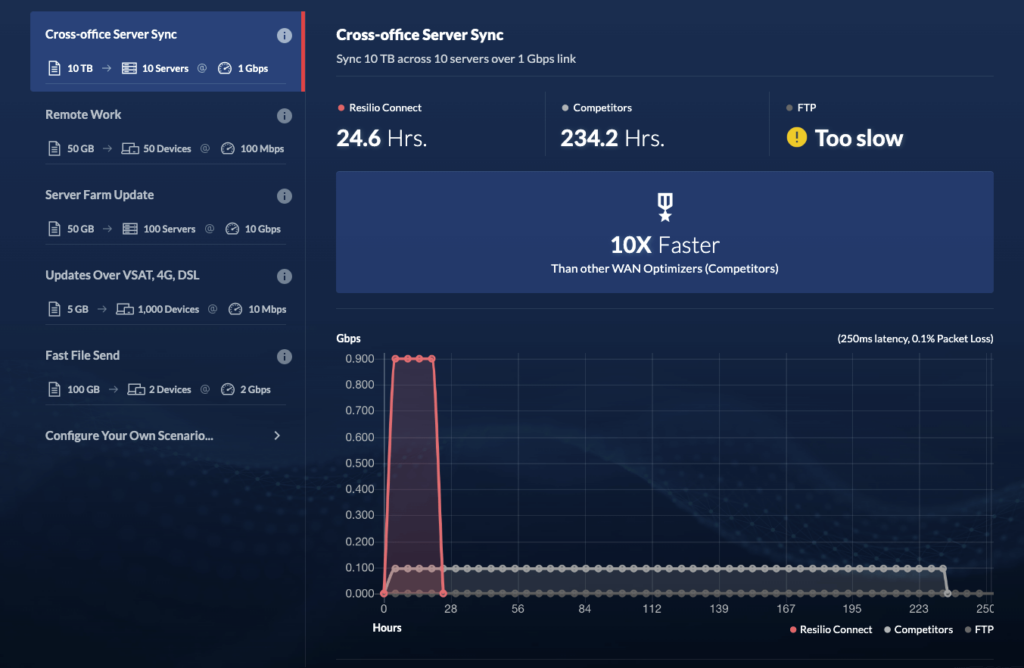
You can also check out the case studies below for more details on how Resilio Connect helps real-life organizations in their day-to-day:
- Turner Sports uses Resilio Connect to sync the files on the local server in the media truck to their SAN in Atlanta via a WAN (usually a standard 1Gbps Internet connection or private layer 3 circuit).
- One of the world’s largest marine construction companies uses Resilio Connect on 30 of its vessels to guarantee high-speed, reliable data transfers from shore to ship and back.
- Mixhits Radio uses Resilio Connect to predictably and continuously deliver high-quality music experiences to its customers across the U.S.
Solution #2: Unique P2P Architecture
Unlike traditional file transfer and replication solutions, Resilio Connect employs a unique P2P (peer-to-peer) architecture.
With this architecture, every device can share data directly with the others in your environment. For example, any changes on Device 1 can be shared directly between Devices 2, 3, 4, 5, and so on. This eliminates the need for cloud-hopping and massively speeds up transfer times.
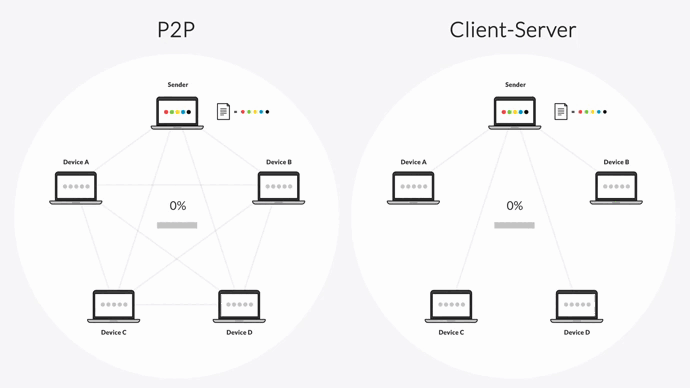
Resilio Connect further speeds up transfers with a process called file chunking.
File chunking turns files into several pieces that can be transferred independently from each other, leading to transfer speeds that are 3-10 times faster than traditional solutions.
This makes Resilio Connect one of the few tools that can perform true bidirectional sync, including:
- One-to-one transfer.
- One-to-many transfer.
- Many-to-one transfer.
- N-way transfer.
Lastly, thanks to the P2P architecture, Resilio Connect is an organically scalable solution.
Because every device in your environment acts as a hub, adding more demand automatically creates more supply. For example, Resilio can synchronize data 50% faster than point-to-point solutions in a 1:2 scenario and 500% faster in a 1:10 scenario.
This makes our software incredibly valuable for applications that rely on serving the right data at the right time to many geographically dispersed users.
Bonus: Resilio Connect’s Other Key Benefits
Besides the industry-leading transfer speeds, our customers also experience five other key benefits from Resilio Connect.
- Simplicity and ease of use.
- Resilience and fault tolerance.
- Region, service, cloud, and deployment flexibility.
- End-to-end security.
- Efficiency.
Additional Benefit #1: Simplicity & Centralized Management
Resilio Connect’s Central Management Console lets you manage every aspect of data transfer, replication, and access from a single place.
You can use the console to track, debug, and adjust key transfer and replication parameters, like buffer size, bandwidth usage policies, disk I/O threads, and more. This is essential for ensuring data is moving efficiently as possible across regions and services.

You can also use the console to set up:
- Rules and notification parameters.
- User permissions.
- Webhooks.
Finally, the console can be stored in Amazon EC2 or on any Windows or Linux instance (virtual or physical) located in any cloud, on-premises, or anywhere else that suits your needs.
Additional Benefit #2: High Resilience and Fault Tolerance
Unlike traditional topologies, Resilio Connect’s P2P architecture doesn’t have a single point of failure. When one device in your environment fails, our software can always access data from the other devices.
Plus, the ZGT transfer protocol is sensitive to bandwidth changes, allowing it to optimize data transfer over any network. As a result, data is dynamically routed around failures to overcome latency and network congestion.
Resilio’s combination of high performance and high availability helps organizations meet sub-five-second RPOs (Recovery Point Objectives) and RTOs (Recovery Time Objectives) within minutes of an outage.
This makes Resilio ideal for all kinds of disaster recovery (DR) scenarios, including:
- Cold DR
- Warm-site DR
- Offsite copy
- Hot-site DR
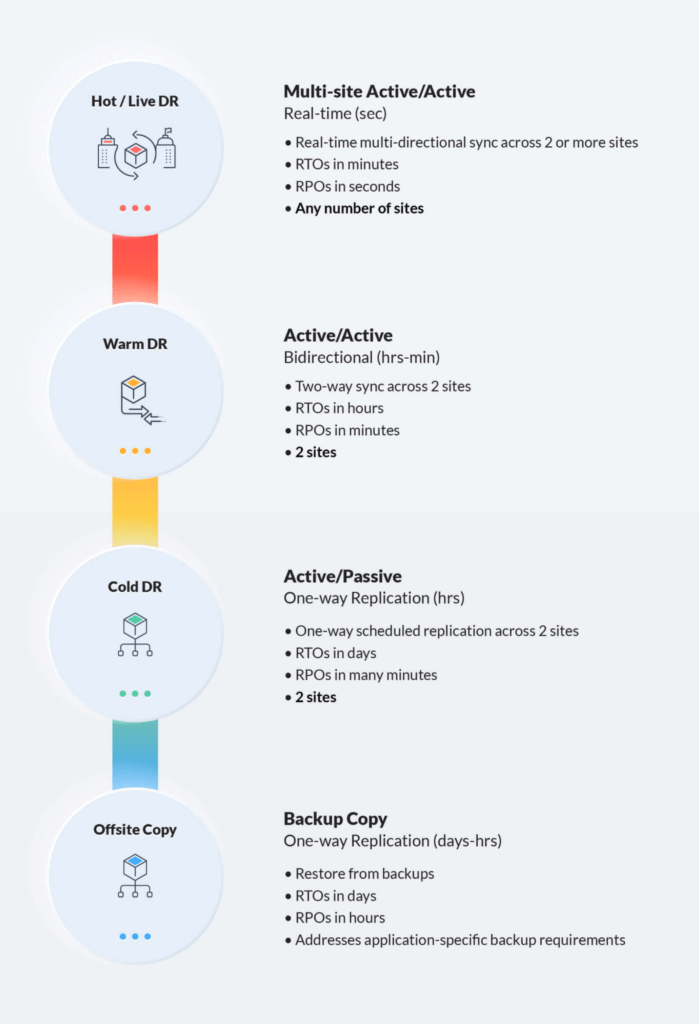
For example, a large US-based construction company relies on Resilio Connect to recover files much faster than their previous solution (DSFR). Our software’s speed, reliability, and resilience helped the company save $8.6 million in remote access to graphics-intensive 3D workstations.
“Our file recovery times were substantially decreased with Resilio. Our recovery time took 3 or 4 days using DFSR and we could not meet our RTOs. Using Resilio Connect, we can restore a single file — in some cases in less than a minute — using the exact same IT infrastructure (servers, storage, and DFS namespace).”
For more details on their challenges and use cases, read our case study.
Additional Benefit #3: Region, Service, Cloud, and Deployment Flexibility
Resilio Connect is an agent-based, software-only multi-cloud solution. This means you can:
- Deploy it on your existing infrastructure (servers, networks, and desktops) and storage, including NAS, DAS, SAN, and more. There’s no need to migrate data or buy new hardware and train your team.
- Use Resilio with popular operating systems, like Mac, Android, Linux, and Windows file servers, and virtualization platforms like VMware Citrix, and more.
- Blend storage from any type of platform or array, like hard drives, storage systems, SSDs, and more.
- Use any type of storage for your data, including file, block, or object.
Resilio Connect is also a cloud-agnostic solution that builds on open standards, open file formats, and a multi-cloud architecture. As a result, you have full freedom to:
- Ingest your data into AWS and move it between different regions and services. For example, you can quickly move data between S3 buckets in us-west-1 (N. California), eu-north-1 (Stockholm), ap-northeast-2 (Seoul), me-south-1 (Bahrain), and af-south-1 (Cape Town).
- Move, sync, and replicate data across other cloud providers and on-prem storage. You can use the Central Management Console to transfer data between multiple cloud providers like AWS, Azure, GCP, Wasabi, Backblaze, and any other S3-compatible object storage.
In short, Resilio Connect lets you avoid vendor lock-in, move data quickly and reliably, and spin up or tear down projects in any cloud at a moment’s notice.
Additional Benefit #4: End-to-End Security
Security is always a priority when it comes to moving data across cloud services, regions, and providers.
That’s why we’ve developed enterprise-grade security features for Resilio Connect that are reviewed by 3rd-party experts.
These features include:
- End-to-end encryption, which encrypts data at rest and in transit using AES 256.
- Mutual authentication, which ensures Resilio only delivers files to designated endpoints.
- Cryptographic data integrity validation to guarantee files arrive at their destination uncorrupted.
- Data immutability, which means Resilio stores immutable copies of data in the public cloud, protecting you from ransomware and data loss.
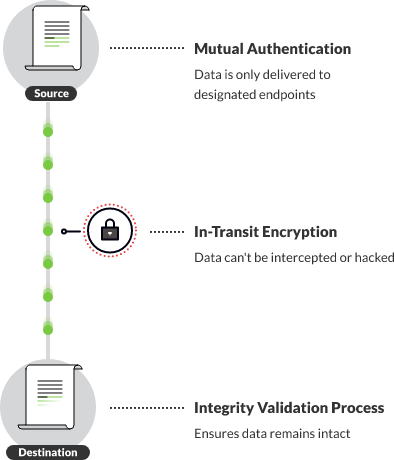
Additional Benefit #5: Efficiency
As we said earlier, with Resilio Connect, every server in your environment can transfer data. This makes data transfer and replication much more efficient as you can:
- Quickly transfer data across AWS services and regions (and other cloud providers).
- Replicate and sync data in any direction — one-to-one, two-way, one-to-many, many-to-one, and N-way.
Our engineering team is constantly looking to boost Resilio’s efficiency by improving its energy consumption and cost efficiency.
In one recent update, we optimized time, merging, CPU usage, indexing, storage I/O, and end-to-end transport — reducing the average memory footprint required on replication jobs by 80%.
Lastly, Resilio Connect offers three distinct capabilities that help you transfer data in a cost-effective way:
- Transparent Selective Sync (TSS), which makes it easy to only initiate transfers of the data you’ve selected. This reduces the amount of data being moved and results in much lower AWS cross-region data transfer costs.
- Smart Routing, which lets you choose which network you want to keep your traffic on. For example, you can keep all traffic on the AWS network or move data to a remote edge network to keep traffic on a LAN, instead of on a more expensive WAN.
- Local file storage, which means you can keep frequently accessed files on local storage, so you don’t have to download them from the AWS cloud every time you need them. This can drastically lower your egress fees.
Note: For a deeper dive into this topic, check out our article on the best AWS File Gateway alternative.
Transfer Data Across Regions, Services, and Clouds with Industry-Leading Speed
Resilio Connect is an ideal solution for companies that need lightning-fast, reliable data transfer across any cloud region, service, and on-prem storage.
Our software’s unique P2P architecture, WAN optimization technology, and a myriad of useful features make it:
- Highly resilient, fault-tolerant, and ideal for disaster recovery scenarios.
- Organically scalable because it performs better as you add more endpoints.
- Easy to manage, as you can control all aspects of data transfer and access from a single interface.
- Flexible, as you can use it with various AWS services, other cloud providers, and on-prem environments.
- Secure, thanks to AES 256 encryption and other security features that have been verified by 3rd-party security experts.
To learn more about how Resilio Connect can help your business, schedule a demo with our team.





